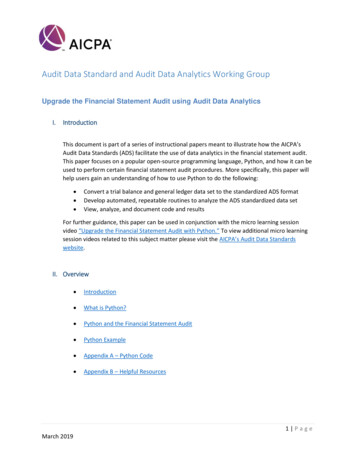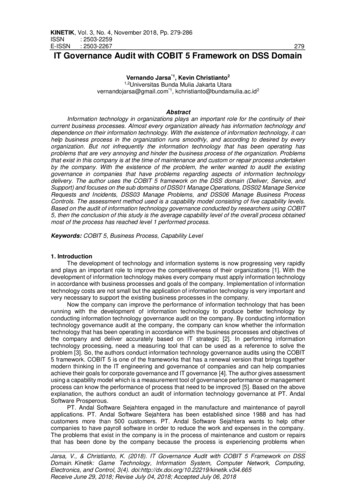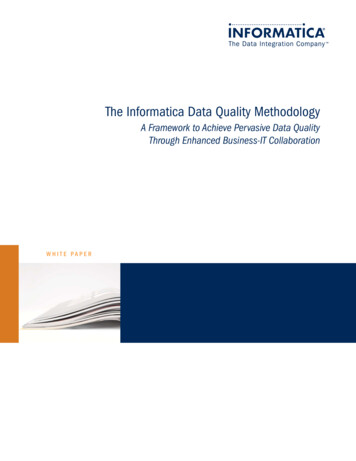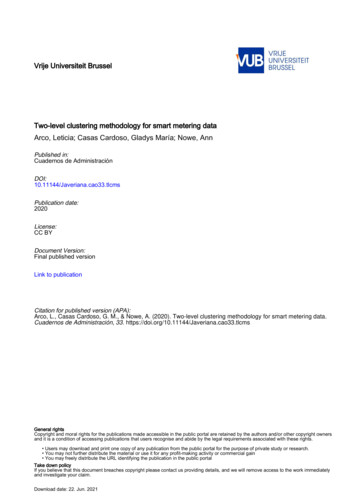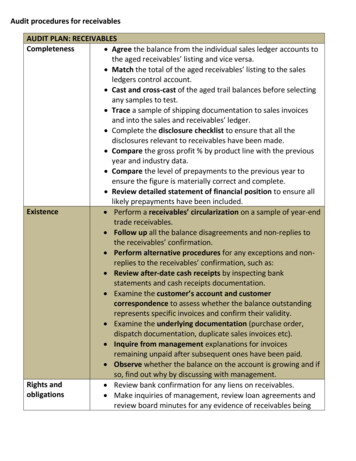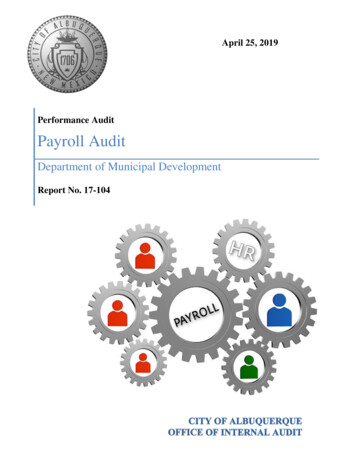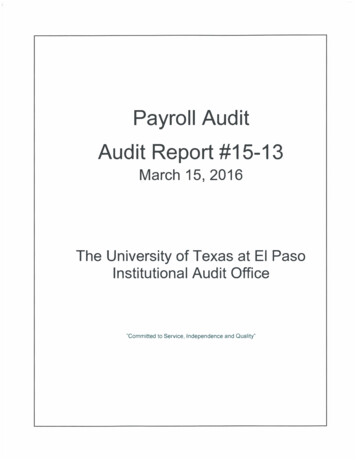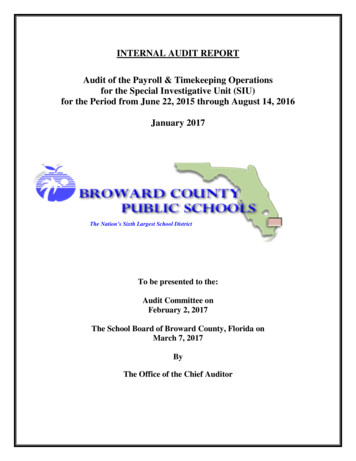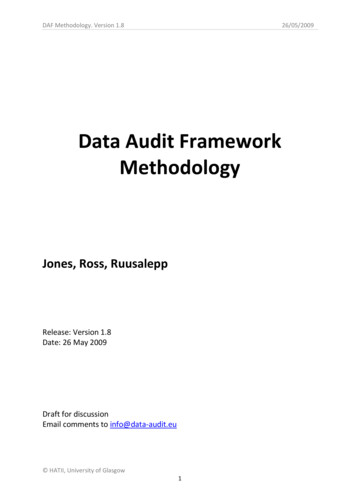
Transcription
DAF Methodology. Version 1.826/05/2009Data Audit FrameworkMethodologyJones, Ross, RuusaleppRelease: Version 1.8Date: 26 May 2009Draft for discussionEmail comments to info@data-audit.eu HATII, University of Glasgow1
DAF Methodology. Version 1.826/05/2009Catalogue entryTitleData Audit Framework MethodologyCreatorHumanities Advanced Technology and information Institute(HATII), University of GlasgowSubjectaudit; research data; higher education; further education;data management.DescriptionThe methodology presented here provides specific guidanceon how to plan and execute an audit of research data assetsin line with the Data Audit Framework (DAF) conceived bythe JISC-funded DAFD project. DAF will enable institutions tofind out what data they hold, where it is located and who is(or is not) responsible for it, as well as offering a tool formanaging this information and sharing it with otherorganisations in a controlled environment.PublisherHATII at the University of GlasgowContributorSarah JonesContributorSeamus RossContributorRaivo RuusaleppContributorMilena DobrevaDate2009.05.26TypeTextFormatAdobe Portable Document Format v.1.8LanguageEnglishRights HATII, University of GlasgowCitation GuidelinesJones, S., Ross, S., and Ruusalepp, R., Data Audit Framework Methodology, draft for discussion,version 1.8, (Glasgow, HATII, May 2009)Copyright NoticesText and diagrams HATII, University of Glasgow HATII, University of Glasgow2
DAF Methodology. Version 1.826/05/2009TABLE OF CONTENTSPART I BACKGROUND TO THE DATA AUDIT FRAMEWORK . 51)a)b)c)d)e)Overview. 5Executive summary . 5Introduction . 5Glossary of Terms. 5Scope of the Data Audit Framework. 6Caveats. 7a)b)The Need for a Data Audit Framework . 8Why Audit Data Assets?. 8How the Data Audit Framework can Help . 92)PART II THE DATA AUDIT FRAMEWORK TOOLKIT. 113)a)b)Guidance for using the Data Audit Framework. 11How to Use the Data Audit Framework. 11Support for those Using the Data Audit Framework . 14a)b)c)d)e)f)Stage 1: Planning the audit. 15Aim of this Stage . 15Tasks Associated with this Stage. 15Anticipated Results of this Stage . 15What Resources are Required to Complete this Stage?. 15Instructions for Completing the Stage . 17Checklist . 21a)b)c)d)e)f)g)h)Stage 2: Identifying and classifying data assets . 22Aim of this Stage . 22Tasks Associated with this Stage. 22Anticipated Results of this Stage . 22What Resources are Required to Complete this Stage?. 22Instructions for Completing the Stage . 24What to do in the Event of Required Information Being Unavailable. 28Discussion. 29Checklist . 30a)b)c)d)e)f)Stage 3: Assessing the management of data assets. 31Aim of this Stage . 31Tasks Associated with this Stage. 31Anticipated Results of this Stage . 31What Resources are Required to Complete this Stage?. 31Instructions for Completing the Stage . 32Checklist . 364)5)6) HATII, University of Glasgow3
DAF Methodology. Version 1.87)26/05/2009Stage 4: Reporting results and making recommendations . 37a)Aim of this Stage . 37b)Tasks Associated with this Stage. 37c)Anticipated Results of this Stage . 37d)What Resources are Required to Complete this Stage?. 37e)Instructions for Completing the Stage . 38f)Checklist . 40APPENDICES. 418)Appendix 1: Template audit forms and worked examples . 41a)Audit Form 1: Audited organisation . 41b)Audit Form 2: Inventory of data assets. 43c)Audit Form 3: Data asset management . 459)a)b)Appendix 2: Forms. 52Ethical approval forms . 52Proposed audit timetable for on-site activities . 5810)a)b)c)d)Appendix 3: Guidance documents. 59Example email approach to target organisation. 59Formula for establishing how much time is needed to complete a data audit. 59Example business case. 62Lessons learned reports. 63 HATII, University of Glasgow4
DAF Methodology. Version 1.826/05/2009PART I BACKGROUND TO THE DATA AUDIT FRAMEWORK1)Overviewa) Executive summaryThe Data Audit Framework Development (DAFD) project was conceived in direct response torecommendations made by Liz Lyon in the seminal JISC-commissioned report Dealing with Data: ‘aframework must be conceived to enable all universities and colleges to carry out an audit ofdepartmental data collections, awareness, policies and practice for data curation and preservation.’The aim of the DAFD project is to develop and provide examples for a Data Audit Framework (DAF)adapted to the current needs of data curation activities in UK Higher and Further Educationinstitutions. The project will develop a general solution as well as highlight, through case studies,differences caused by research field and organisation type. DAF will enable institutions to find outwhat data they hold, where it is located and who is (or is not) responsible for it, as well as offering atool for managing this information and sharing it with other organisations in a controlled environment.The DAFD project will distribute a software tool intended to support and facilitate data audit thatincorporates a registry component for recording the results of data audits. This tool will provide apowerful mechanism to enable institutions to know what data they have and where it is. Theaccompanying registry will provide a national perspective of UK research data assets to facilitatefuture research collaborations and strategic planning.b) IntroductionThe methodology presented here provides specific guidance on how to plan and execute an audit ofdata assets in line with the Data Audit Framework conceived by the JISC-funded DAFD project. Thefirst two chapters provide background information. Chapter 1 provides details on the scope of theData Audit Framework and chapter 2 addresses the need for an audit framework, providing severalbenefits that could be used to formulate a business case. Chapters 3-7 are concerned with thepractical work of the audit. Chapter 3 provides details on how to use the Data Audit Framework,chapter 4 covers planning the audit, chapter 5 identifying and classifying assets, chapter 6 assessingthe management of data assets, and chapter 7 final reporting and recommendations. Templatedocuments and additional guidance materials for completing the audit are available in the appendices.c) Glossary of TermsThe definitions below identify specific meanings attributed to common terms within the context of theData Audit Framework.auditorappraisala nominated representative, either from within the department / institution beingaudited or an external individual, who has been chosen to identify and assess thecurrent value and condition of data assets to make recommendations for theirlong term management and preservationthe process of determining the length of time records should be retained, basedon legal requirements and on their current and potential usefulness11Richard Pearce-Moses, A Glosary of Archival and Records Terminology, (2005), available at:http://www.archivists.org/glossary/index.asp HATII, University of Glasgow5
DAF Methodology. Version 1.8Data AuditFrameworkdata assetsdata collectionsdata 9a framework developed by the JISC-funded DAFD project to identify data assetsheld within Higher and Further Educational institutions and to explore how theyare managed. The framework is structured around audit at departmental or unitlevel with results being amassed to obtain an institutional or national perspective.broad terms to cover all research data created in Higher and Further Education,including the outputs of funded research projects as well as academics’ personaldata collections created over the course of their careeraudits are often described here as being conducted within departments as most ofthe test audits took place at this level. This is not to suggest that the Framework isonly suitable for use at this level; indeed, departmental audits could be scaled upto provide an institution-wide survey or the Framework could be applied directlyat such a level using a top-down approach. As such the terms institution andorganisation are also used throughout the various sections.a detailed list of data assets created by and/or used within an organisationdata or information in a fixed form that is created or received in the course ofindividual or institutional activity and set aside (preserved) as evidence of thatactivity for future reference2an online system to collect audit results, allowing this data to be federated atinstitutional or national level. The registry will continue to grow long after theDAFD project ends, enhancing its usefulness as a national reference point.d) Scope of the Data Audit FrameworkEducational institutions create a wide array of digital assets, including learning objects, electronicjournal articles, publications, web resources and datasets. A decision was made between DAFD projectmanagement and the JISC to restrict the scope of t
Data Audit Framework and chapter 2 addresses the need for an audit framework, providing several benefits that could be used to formulate a business case. Chapters 3-7 are concerned with the
